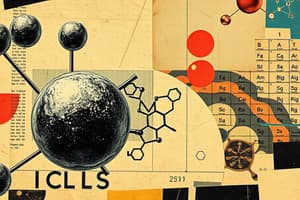Podcast
Questions and Answers
Which statement accurately describes the roles of both DNA polymerase and RNA polymerase?
Which statement accurately describes the roles of both DNA polymerase and RNA polymerase?
- Both synthesize nucleic acids in the 5' to 3' direction, but DNA polymerase requires a primer while RNA polymerase does not. (correct)
- Both can initiate synthesis _de novo_ (without a primer) and synthesize identical copies of a template strand.
- Both require a DNA template for synthesis, but DNA polymerase uses ribonucleotides and RNA polymerase uses deoxyribonucleotides.
- Both are involved in proofreading newly synthesized strands, ensuring high fidelity in replication and transcription.
During protein synthesis, what dictates the order of amino acids added to the growing polypeptide chain?
During protein synthesis, what dictates the order of amino acids added to the growing polypeptide chain?
- The specificity of aminoacyl-tRNA synthetases for each amino acid.
- The sequence of codons in the mRNA molecule. (correct)
- The arrangement of ribosomes along the endoplasmic reticulum.
- The availability of free amino acids in the cytoplasm.
A mutation in a gene results in a non-functional enzyme. Which scenario is MOST likely to explain this outcome?
A mutation in a gene results in a non-functional enzyme. Which scenario is MOST likely to explain this outcome?
- The mutation increased the enzyme's affinity for its substrate, causing it to become permanently bound.
- The mutation was a silent mutation, which did not change the amino acid sequence.
- The mutation caused a frameshift, leading to a completely different amino acid sequence after the mutation point. (correct)
- The mutation occurred in an intron, preventing proper splicing of the mRNA.
How does the structure of RNA differ from the structure of DNA, influencing their respective roles in a cell?
How does the structure of RNA differ from the structure of DNA, influencing their respective roles in a cell?
If a segment of DNA has the sequence 5'-GATTACA-3', what would be the sequence of the complementary strand produced during DNA replication?
If a segment of DNA has the sequence 5'-GATTACA-3', what would be the sequence of the complementary strand produced during DNA replication?
In eukaryotic cells, the process of transcription involves several steps. What event typically occurs after the pre-mRNA has been transcribed but before it leaves the nucleus?
In eukaryotic cells, the process of transcription involves several steps. What event typically occurs after the pre-mRNA has been transcribed but before it leaves the nucleus?
A certain protein is found to be produced in large quantities in muscle cells but is barely detectable in nerve cells. What mechanism MOST likely accounts for this difference?
A certain protein is found to be produced in large quantities in muscle cells but is barely detectable in nerve cells. What mechanism MOST likely accounts for this difference?
Which modification of histone proteins would MOST likely result in increased gene expression?
Which modification of histone proteins would MOST likely result in increased gene expression?
A researcher introduces a mutation into the promoter region of a bacterial gene. The mutation reduces, but does not eliminate, the binding of RNA polymerase. How will this mutation MOST likely affect gene expression?
A researcher introduces a mutation into the promoter region of a bacterial gene. The mutation reduces, but does not eliminate, the binding of RNA polymerase. How will this mutation MOST likely affect gene expression?
During the process of translation, a tRNA molecule with the anticodon 3'-AUG-5' binds to which mRNA codon?
During the process of translation, a tRNA molecule with the anticodon 3'-AUG-5' binds to which mRNA codon?
Flashcards
Metabolism
Metabolism
The sum of all enzyme-catalyzed reactions in a cell or organism.
Cohesion
Cohesion
The property of water is due to hydrogen bonds between its molecules.
Carbohydrates
Carbohydrates
A class of organic compounds that include sugars, starches, and cellulose.
Lipids
Lipids
Signup and view all the flashcards
Proteins
Proteins
Signup and view all the flashcards
Enzymes
Enzymes
Signup and view all the flashcards
DNA
DNA
Signup and view all the flashcards
RNA
RNA
Signup and view all the flashcards
DNA Replication
DNA Replication
Signup and view all the flashcards
Transcription
Transcription
Signup and view all the flashcards
Study Notes
Topic 2: Molecular Biology
- This topic covers molecules to metabolism, water, carbohydrates and lipids, proteins, enzymes, DNA/RNA structure, DNA replication, transcription & translation, cell respiration, and photosynthesis.
2.1 Molecules to Metabolism
- This section likely discusses the basic molecules involved in metabolic processes.
2.2 Water
- This section probably covers the properties of water and its role in biological processes.
2.3 Carbohydrates and Lipids
- This section focuses on the structure, functions, and importance of carbohydrates and lipids in living organisms.
2.4 Proteins
- This section will likely cover the structure, function, and diversity of proteins, including amino acids and protein folding.
2.5 Enzymes
- This section most likely discusses the function of enzymes as biological catalysts and factors affecting enzyme activity.
2.6 Structure of DNA and RNA
- This section probably covers the building blocks, structure, and differences between DNA and RNA.
2.7 DNA Replication, Transcription & Translation
- This section likely explains the processes of DNA replication, transcription of DNA into RNA, and translation of RNA into proteins.
2.8 Cell Respiration
- This section probably covers the process of cell respiration, including glycolysis, Krebs cycle, and the electron transport chain.
2.9 Photosynthesis
- This section most likely covers the process of photosynthesis, including light-dependent and light-independent reactions.
Studying That Suits You
Use AI to generate personalized quizzes and flashcards to suit your learning preferences.



